The flower of the orchid is the flower of the orchid.
Wandailan is not only dignified and beautiful in appearance, but also tenacious in vitality, and can still reveal its fragrance under adverse conditions, so it was chosen as the national flower of Singapore. Next, the editor will introduce to you the culture method of Wandailan, the flower language of Wandailan for your reference.
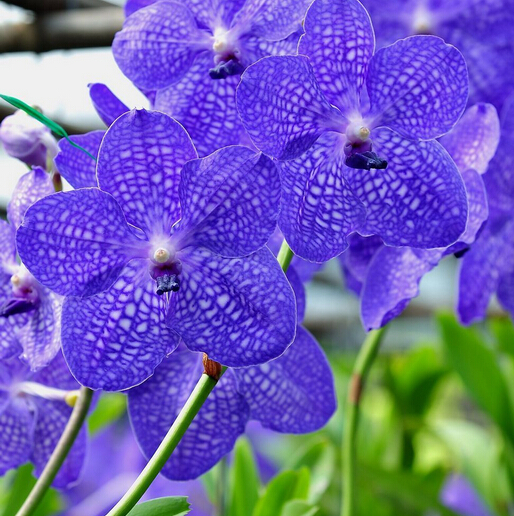
Wandailan was originally the Sanskrit language of India, meaning orchids hanging on trees. She is a very special orchid. Do not need soil, do not need any plant material, can grow very exuberantly. She is a kind of gas orchid, which only relies on the air root to absorb oxygen in the air. In the wild, it grows with tree trunks or stones, which seems to surpass our understanding of plants and make people feel magical.
Culture method of Wandai orchid
Wandailan needs more fertilizer than other orchids, so during the period of vigorous growth, diluted fertilizer can be applied every 7 to 10 days. The best fertilizer is the ratio of nitrogen, phosphorus and potassium at 10:10:5. Because the roots of Wandailan are aerial roots, all media with good drainage can be applied, such as snake sawdust, broken bricks, charcoal, coarse gravel sand, etc., whether used alone or mixed, are good basin soil. In addition to the medium, the pots must also be very fastidious. In pots of various materials, wooden striped pots and pottery pots are the best, and a few more holes are pierced in the pots, which are more conducive to good drainage and air circulation. Wandailan can also grow well on snake boards or tree trunks. Wandailan should not change the basin frequently, unless it is disturbed by diseases and insect pests, it can be changed at least once every 3 years.
The Wandai orchid in spring is about to enter the vigorous growth period, which is a good time to change the basin. Wandai orchid, which has been growing for many years, its root system will be tightly attached to the inner wall of the pot, so if it is planted in a pottery basin, it is best to break the basin and change the pot, so as not to damage the root system when taking out the plant.
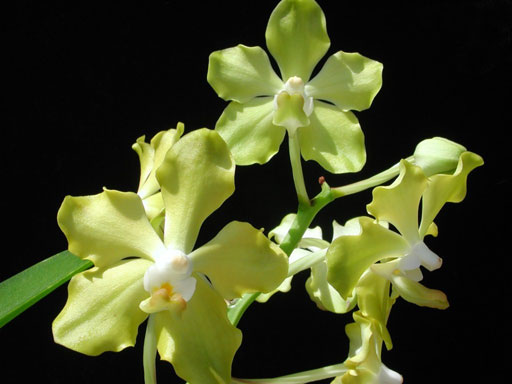
Finally, no matter how it is cultivated, keep in mind that the basin soil must be well drained and well ventilated.
The propagation of Wandai orchid can be done in tissue culture or high bud propagation, however, the former is not suitable for home because it requires more professional skills. At the end of autumn, Wandailan grows tall buds in the axils of the leaves. When the tall buds grow to 5~7.5cm, cut off the tall buds from the mother plant with a sharp and sterilized knife and plant them in a basin filled with snake sawdust, which can be transplanted to a larger basin. Remember to apply medicine on the incision to avoid being infected by germs.
In addition, when the plants cultivated for many years grow to more than 1m, you can cut off the terminal buds about 30~46cm, apply medicine to disinfect the incisions on both sides, and then plant them in a basin to keep them wet. The tough leaves of pest control are the main reason why Wandailan is not easy to suffer from diseases and insect pests. with the exception of snails and slugs, common pests are rarely found on strong orchid plants. However, when the water is retained in the leaves for too long, or infected by the virus, some dark markings or patches often appear, and gradually rot. If the condition is mild, the affected area can be removed. In case the range of decay is too wide, the whole orchid must be discarded so as not to infect other orchid plants.
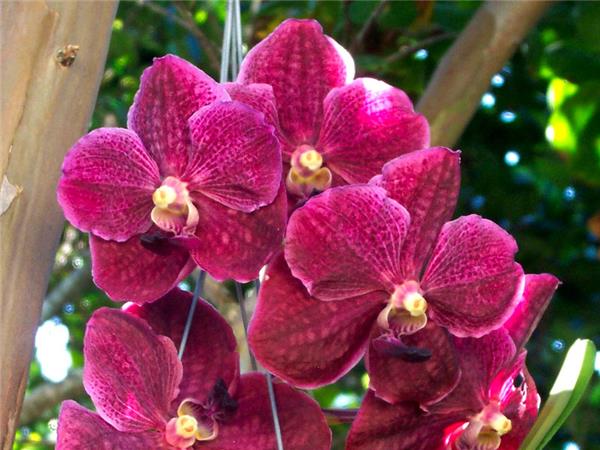
The Flower language of Wandailan
The flower language of Wandailan: individuality, outstanding beauty and immortality.
Wandailan looks beautiful and dignified, outstanding, and reveals humility, symbolizing the temperament of the people of Singapore. Wandailan has a beautiful lip film and five honorable films, which symbolize the equality between the four ethnic groups of Singapore and Malay, English, Chinese and Tamil.
The evil pillar in the middle of the flowers of Wandailan, androgynous, symbolizes the root of happiness. The flowers are arched and supported by opposite segments below, symbolizing harmony, joys and sorrows, and glory and disgrace. Behind the lip piece of Wandailan flower, there is a bag-shaped horn with sweet juice, symbolizing the place where wealth converges.
Uncover the pollen cover on the pillar of Wandailan, there are two pieces of flowers, like two "golden eyes", symbolizing foresight. The stem of Wandailan climbs upward, symbolizing upward development and prosperity. Its flowers fall one by one and bloom again and again, symbolizing the lifeblood of the Singapore nation. It has a long history and has endless confidence and hope.
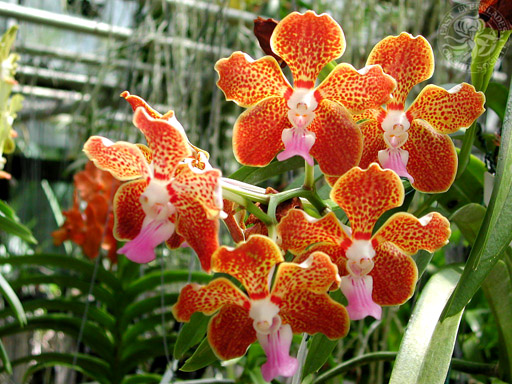
Key points of maintenance of Wandailan
Perennial evergreen epiphytic herb. The flowers are large and colorful, and there are many varieties. At present, all the cultivated varieties are excellent hybrid varieties. Usually planted with four-wall porous flowerpots or wooden boxes, hanging in the greenhouse; using charcoal, broken bricks and so on as the matrix. The root is required to have excellent air permeability, like high temperature and humidity, and the normal growth temperature is above 20 ℃. Like plenty of sunshine, shade 30% and 50% in greenhouse cultivation in the north. Maintain high air humidity. Fertilizer was sprayed on the leaves every 1-2 weeks during the growing period. Spray water on the plant once or twice a day.
Reproduction: ramet, aseptic sowing and tissue culture.
Lighting: like strong light, not resistant to shade (sufficient light).
Moisture: growing in moist soil.
Temperature: not cold-resistant, frost injury will occur below 0 ℃.
Humidity: like to be moist, the relative humidity is higher than 60%, generally 70% to 90%.
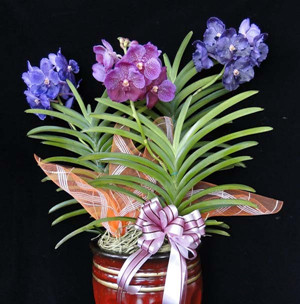
Well, the flower language editor of Wandailan, the breeding method of Wandailan, is introduced here. Although Wandailan is delicate and beautiful in appearance, it has a firm heart, which is not as weak as other orchids and can bloom beautifully under difficult conditions.
There are many varieties. At present, all the cultivated varieties are excellent hybrid varieties. Usually planted with four-wall porous flowerpots or wooden boxes, hanging in the greenhouse; using charcoal, broken bricks and so on as the matrix. The root is required to have excellent air permeability, like high temperature and humidity, and the normal growth temperature is above 20 ℃. Like plenty of sunshine, shade 30% and 50% in greenhouse cultivation in the north. Maintain high air humidity. Fertilizer was sprayed on the leaves every 1-2 weeks during the growing period. Spray water on the plant once or twice a day.
Reproduction: ramet, aseptic sowing and tissue culture.
Lighting: like strong light, not resistant to shade (sufficient light).
Moisture: growing in moist soil.
Temperature: not cold-resistant, frost injury will occur below 0 ℃.
Humidity: like to be moist, the relative humidity is higher than 60%, generally 70% to 90%.

Well, the flower language editor of Wandailan, the breeding method of Wandailan, is introduced here. Although Wandailan is delicate and beautiful in appearance, it has a firm heart, which is not as weak as other orchids and can bloom beautifully under difficult conditions.
Related
- Wuhan Hospital Iron Tree Blooming Result Was Instantly Frightened by the Gardener Master
- Which variety of camellia is the most fragrant and best? Which one do you like best?
- What is the small blue coat, the breeding methods and matters needing attention of the succulent plant
- Dormancy time and maintenance management of succulent plants during dormancy
- Minas succulent how to raise, Minas succulent plant pictures
- What are the varieties of winter succulent plants
- How to raise succulent plants in twelve rolls? let's take a look at some experience of breeding twelve rolls.
- Attention should be paid to water control for succulent plants during dormant period (winter and summer)
- Watering experience of twelve rolls of succulent plants
- Techniques for fertilizing succulent plants. An article will let you know how to fertilize succulent plants.



